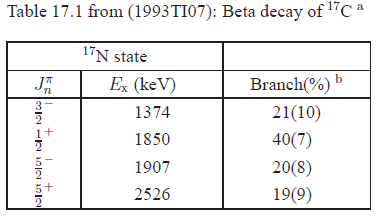Evaluation Home Page |
| Information on mass chains and nuclides |
|
|



17C (1993TI07)
(See the Isobar Diagram for 17C)
The atomic mass excess given by (1988WA18) for 17C is 21035 ± 17 keV. See also (1986AN07). 17C is then stable with respect to 16C + n by 0.73 MeV. Eβ- (max) to 17Ng.s. = 13.16 MeV. See also (1986BI1A). The half-life of 17C has been measured to be 202 ± 17 msec (1986CU01), 220 ± 80 msec (1986DU07), 180 ± 31 msec (1988SA04), and 174 ± 31 msec (1991RE02). Relative intensities of β-delayed gammas were
measured by (1986DU07, 1986HU1A, 1986JEZY) [see  17.1 (in PDF or PS)]. Observation of β-delayed neutron emission has been reported and the probability measured to be (32.0 ± 2.7)% by (1991RE02). See also (1988MU08). Total cross sections induced by 17C on Cu were measured by (1989SA10). See also (1987SA25). An excited state of 17C is reported at Ex = 292 ± 20 keV [see (1982AJ01)] and at 295 ± 10 keV (1982FI10). Three closely spaced low-lying states are expected [Jπ = 5/2+, 3/2+,
1/2+] (1982CUZZ, 1989WA06): it is not clear which is the ground state. See also (1986AJ04).
17.1 (in PDF or PS)]. Observation of β-delayed neutron emission has been reported and the probability measured to be (32.0 ± 2.7)% by (1991RE02). See also (1988MU08). Total cross sections induced by 17C on Cu were measured by (1989SA10). See also (1987SA25). An excited state of 17C is reported at Ex = 292 ± 20 keV [see (1982AJ01)] and at 295 ± 10 keV (1982FI10). Three closely spaced low-lying states are expected [Jπ = 5/2+, 3/2+,
1/2+] (1982CUZZ, 1989WA06): it is not clear which is the ground state. See also (1986AJ04).
Shell-model calculations of energy spectra and wave functions and predictions of half lives and β-decay modes are described in (1989WA06). Hartree-Fock calculations of light neutron-rich nuclei including 17C are discussed in (1987SA15). See also the study of partitioning of a two component particle system in (1987SN01).
![]()
